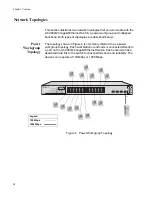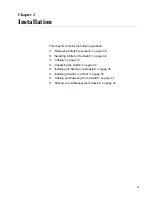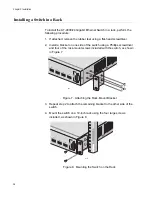
AT-9000/24 Gigabit Ethernet Switch Installation Guide
23
Ethernet Switching Basics
An Ethernet switch interconnects network devices, such as workstations,
printers, routers, and other Ethernet switches, so that they can
communicate with each other by sending and receiving Ethernet frames.
MAC Address
Table
Every hardware device on your network has a unique MAC address. This
address is assigned to the device by the device’s manufacturer. For
example, when you install a Network Interface Card (NIC) in a computer
so that you can connect it to the network, the NIC already has a MAC
address assigned to it by its manufacturer.
The MAC address table in the AT-9000/24 Gigabit Ethernet Switch can
store up to 8K MAC addresses. The switch uses the table to store the
MAC addresses of the network end nodes connected to the ports, along
with the port number on which each address was learned.
A switch learns the MAC addresses of the end nodes by examining the
source address of each packet received on a port. It adds the address and
port on which the packet was received to the MAC table if the address had
not already been entered in the table. The result is a table that contains all
the MAC addresses of the devices that are connected to the switch’s
ports, and the port number where each address was learned.
When the switch receives a packet, it also examines the destination
address and, by referring to its MAC address table, determines the port on
which the destination end node is connected. It then forwards the packet
to the appropriate port and on to the end node. This increases network
bandwidth by limiting each frame to the appropriate port when the
intended end node is located, freeing the other switch ports for receiving
and transmitting data.
If the switch receives a packet with a destination address that is not in the
MAC address table, it floods the packet to all the ports on the switch. If the
ports have been grouped into virtual LANs, the switch floods the packet
only to those ports which belong to the same VLAN as the port on which
the packet was received. This prevents packets from being forwarded into
inappropriate LAN segments, decreasing network security. When the
destination end node responds, the switch adds its MAC address and port
number to the table.
If the switch receives a packet with a destination address that is on the
same port on which the packet was received, it discards the packet without
forwarding it on to any port. Since both the source end node and the
destination end node for the packet are located on the same port on the
switch, there is no reason for the switch to forward the packet.
Duplex Mode
Duplex mode refers to how an end node receives and transmits data. If an
Содержание AT-9000/24
Страница 1: ...613 000239 Rev A Layer 2 Gigabit Ethernet Switch AT 9000 24 Installation Guide...
Страница 6: ...Contents 6 Appendix B Translated Safety Statements 53...
Страница 8: ...Figures 8...
Страница 10: ...Tables 10...
Страница 28: ...Chapter 1 Overview 28...
Страница 46: ...Chapter 2 Installation 46...
Страница 48: ...Chapter 3 Troubleshooting 48...
Страница 52: ...Appendix A Technical Specifications 52...
Страница 74: ...Appendix B Translated Safety Statements 74 1 1 2 3 LAN 4 5 6 I 7 8 9 40 C 10 11 15 LAN OFF 12...
Страница 77: ...AT GA950 16 and AT GA950 24 Gigabit Ethernet Smart Switches Installation Guide 77 41 42 TEL PSTN 43 26 AWG...
Страница 78: ...Appendix B Translated Safety Statements 78...
















































